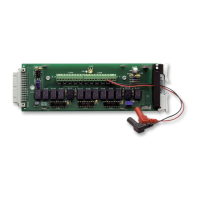Service Information
4-13
4.5 Special handling of static-sensitive
devices
CMOS and other high-impedance devices are subject to pos-
sible static discharge damage because of the high-impedance
levels involved. When handling such devices, use the precau-
tions listed below.
NOTE
In order to prevent damage, assume that all
parts are static-sensitive.
1. Such devices should be transported and handled only in
containers specially designed to prevent or dissipate
static build-up. Typically, these devices will be received
in anti-static containers made of plastic or foam. Keep
these parts in their original containers until ready for in-
stallation or use.
2. Remove the devices from their protective containers
only at a properly grounded workstation. Also, ground
yourself with an appropriate wrist strap while working
with these devices.
Model 2001
(Measure Temperature)
OUT A LO
OUT A HI
Input
HI
Input
LO
Model 2001-TCSCAN in Model 2001
Ice Bath
Channel 2 HI
Channel 2 LO
Copper Wires
R151 Cal
Adjustment
Figure 4-8
Calibration with thermocouple wire
3. Handle the devices only by the body; do not touch the
pins or terminals.
4. Any printed circuit board into which the device is to be
inserted must first be grounded to the bench or table.
5. Use only anti-static type de-soldering tools and ground-
ed-tip soldering irons.
4.6 Principles of operation
The following paragraphs discuss the basic operating princi-
ples for the Model 2001-TCSCAN, and can be used as an aid
in troubleshooting the card. The schematic drawing of the
card is located at the end of Section 5.
4.6.1 Block diagram
Figure 4-9 shows a simplified block diagram of the Model
2001-TCSCAN. Key elements include the relay drivers and
relays, and the power-up reset circuit. These various ele-
ments are discussed in the following paragraphs.

